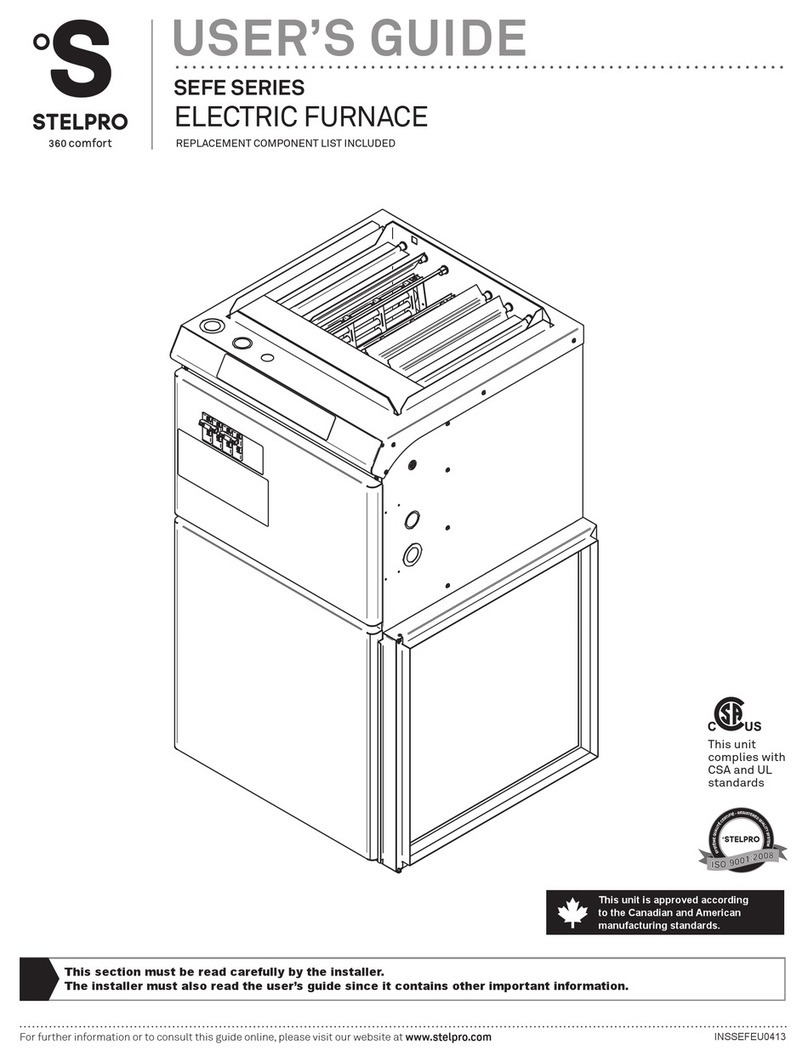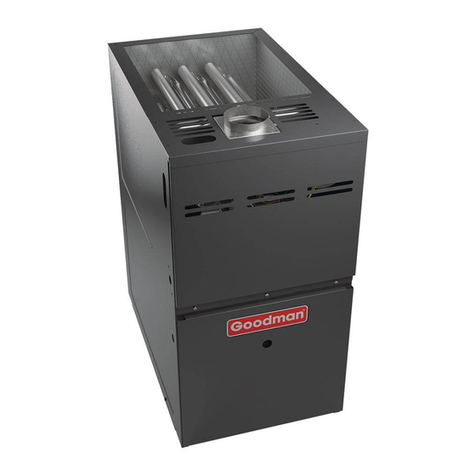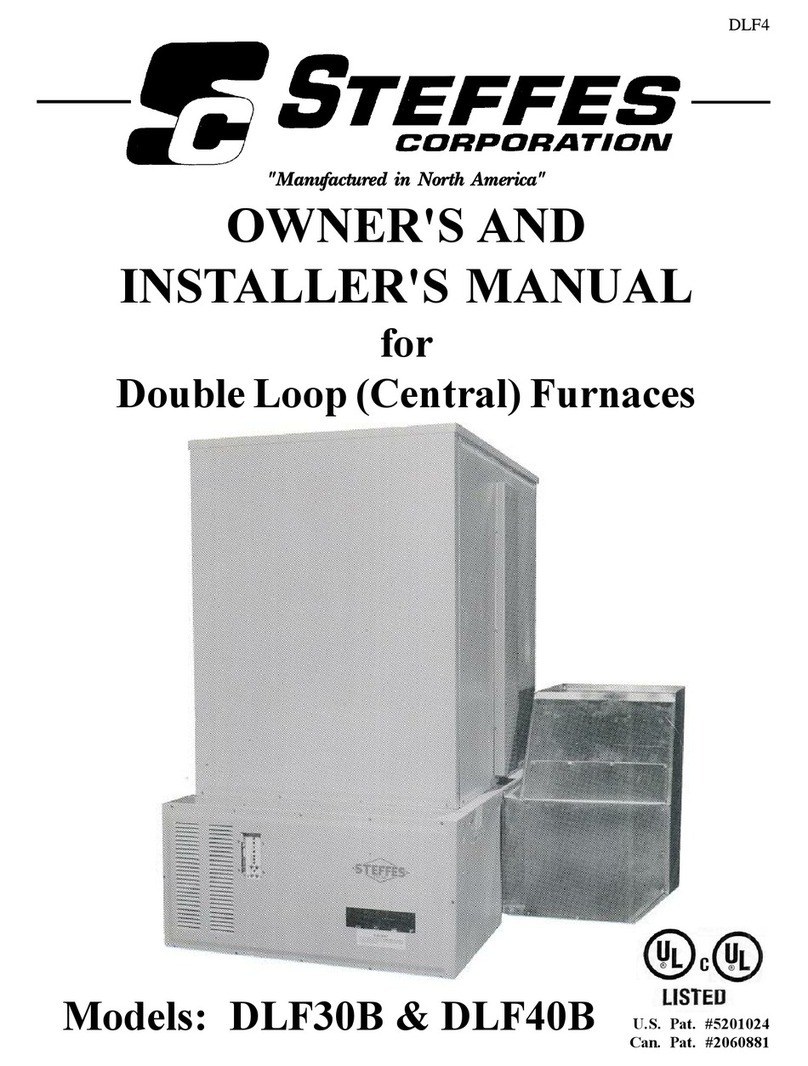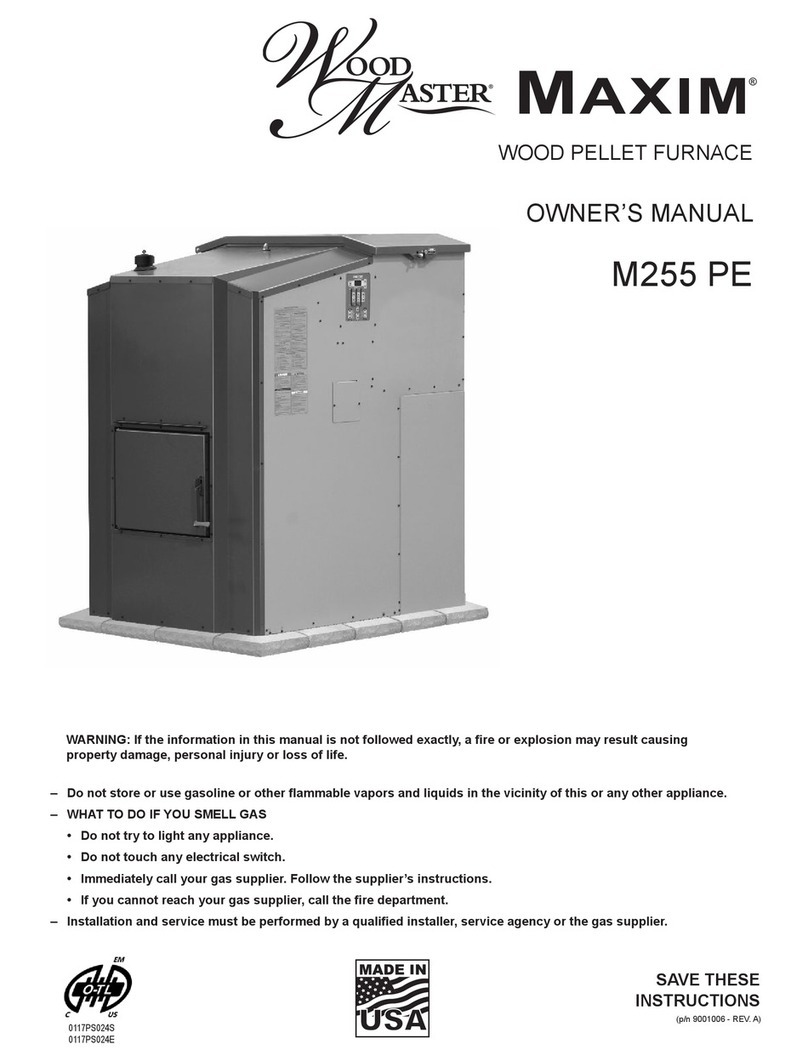Sterling QVSD-100 Troubleshooting guide

INSTALLATION INSTRUCTIONS AND SERVICE MANUAL
STERLING SEPARATED COMBUSTION
GAS-FIRED INDOOR DUCT FURNACE
(S) SCDFM-4
J30-05374
HVAC PRODUCTS
260 NORTH ELM ST., WESTFIELD, MA 01085
TEL: (413) 564-5540 FAX: (413) 562-5311
www.sterlinghvac.com
MODELS: QVSD-100 thru 400
01/11
FORYOUR SAFETY
The use and storage of gasoline or other flammable vapors and liquids in open containers in
the vicinity of this appliance is hazardous.
FORYOUR SAFETY
If you smell gas:
1. Open windows.
2. Don’t touch electrical switches.
3. Extinguish any open flame.
4. Immediately call your gas supplier.
Model No. Serial No.
ATTENTION: READ THIS MANUAL AND ALL LABELS ATTACHED TO THE UNIT CAREFULLY BEFORE
ATTEMPTINGTO INSTALL, OPERATE OR SERVICE THESE UNITS! CHECK UNIT DATA PLATE FORTYPE OF GAS
AND ELECTRICAL SPECIFICATIONS AND MAKE CERTAIN THAT THESE AGREE WITH THOSE AT POINT OF
INSTALLATION. RECORDTHE UNIT MODEL AND SERIAL No.(s) INTHE SPACE PROVIDED. RETAIN FOR FUTURE
REFERENCE.
APPROVED FOR USE IN CALIFORNIA
INSTALLER'S RESPONSIBILITY
InstallerPlease Note:Thisequipment hasbeentestfiredand inspected. Ithasbeenshipped
free from defects from our factory.However, during shipment and installation, problems such
as loose wires, leaks or loose fasteners may occur. It is the installer's responsibility to
inspect and correct any problems that may be found.
RECEIVING INSTRUCTIONS
Inspect shipment immediately when
received to determine if any damage
has occurred to the unit during
shipment. After the unit has been
uncrated, check for any visible
damage to the unit. If any damage is
found, the consignee should sign
the bill of lading indicating such
damage and immediately file claim
for damage with the transportation
company.
Install, operate and maintain unit in accordance with manufacturer's
instructions to avoid exposure to fuel substances or substances from incomplete
combustion which can cause death or serious illness. The state of California
has determined that these substances may cause cancer, birth defects, or other
reproductive harm.
Improper installation, adjustment, alteration, service or maintenance can
cause property damage, injury or death. Read the installation, operating and
maintenance instructions thoroughly before installing or servicing this equipment.

2
TABLE OF CONTENTS
GENERAL SAFETY INFORMATION SEPARATED COMBUSTION DUCT FURNACE ...................................1,2,3
SPECIFICATIONS........................................................................................................................................4
PERFORMANCE DATA................................................................................................................................5
CLEARANCES.............................................................................................................................................6
INSTALLATION
Location...........................................................................................................................................6
Ductwork, Air Flow........................................................................................................................6,7
Suspension......................................................................................................................................7
Electrical Connections, Wiring Diagrams.................................................................................8,9,10
Combustion Air Piping...................................................................................................................11
Exhaust Venting...................................................................................................................11,12,13
Gas Piping.....................................................................................................................................14
Pipe Installation...................................................................................................................15,16,17
OPERATION
Explanation of Controls .................................................................................................................18
Primary Air Shutter Adjustments...................................................................................................18
Shut Down.....................................................................................................................................18
MAINTENANCE ......................................................................................................................................................19
COMPONENT PARTS.............................................................................................................................................20
TROUBLESHOOTING CHART ........................................................................................................................21-25
WARRANTY ...........................................................................................................................................................26
START UP/INSPECTION SHEET ..........................................................................................................................28
GENERAL SAFETY INFORMATION
The duct furnace design is certified by ETL for use with
natural and LP (propane) gases. ANSI and NFPA
Standards as well as Canadian installation codes
referred to in this manual are the ones that were
applicable at the time that the design was certified. In
addition, the duct furnace may be installed on the
downstream side of a cooling coil, without need of a
bypass duct.
If the unit is to be installed at altitudes exceeding 2,000
feet (610m) above sea level, derate the input by 4% for
each 1,000 feet (305m) rise above sea level. Special
orifices are required for installations above 2,000 feet.
When units are installed in Canada, any reference to
derations at altitudes in excess of 2,000 feet (610m) are
to be ignored. At altitudes of 2,000 to 4,500 feet (610 to
1372m), the units must be orificed for 90% of normal
altituderating, andbeso markedin accordancewith ETL
certification.
The following terms are used throughout this manual, in
addition to the CSA requirements to bring attention to
the presence of potential hazards, or to important
information concerning the product:
Indicates an imminently hazardous
situation which,if not avoided,will result in death,
serious injury, or substantial property damage.
Indicates an imminently hazard-
ous situation which, if not avoided, could result
in death, serious injury, or substantial property
damage.
Indicates an imminently hazardous
situation which, if not avoided, may result in minor
injury or property damage.
NOTICE: Used to notify of special instructions on
installation, operation, or maintenance which are
important to equipment but not related to personal
injury.

3
GENERAL SAFETY INFORMATION
Use only the fuel for which the duct furnace is designed
(see rating plate).Using LP gas in a heater that requires
natural gas, of vice versa, will create risk of gas leaks,
carbon monoxide poisoning, and explosion.
Do not attempt to convert furnace
for use with a fuel other than the one intended.
Such conversion is dangerous, as it will create
the risks previously listed.
Make certain that the power source conforms to the
electrical requirements of the furnace.
Do not depend upon a thermostat
or other switch as sole means of disconnecting
power when installing or servicing duct furnace.
Always disconnect power at main circuit breaker
as described above.Failure to do so could result
in electrical shock.
Special attention must be given to any grounding
information pertaining to this duct furnace.To prevent
the risk of electrocution, the furnace must be securely
and adequately grounded.This should be accomplished
by connecting a ground conductor between the service
panel and the furnace.To ensure a proper ground, the
groundingmeans mustbetested byaqualified electrician.
Do not insert fingers or foreign objects into furnace or its
air moving device.Do not block or tamper with the heater
in any manner while in operation, or just after it has been
turned off, as some parts maybe hot enough to cause
injury.
This furnace is intended for general heating applications
ONLY. It must NOT be used in potentially dangerous
locations such as flammable, explosive, chemical-laden,
or wet atmospheres.
In cases in which property damage may result from
malfunction of the furnace, a back-up system or
temperature sensitive alarm should be used.
The open end of piping systems being
purged shall not discharge into areas where there
are sources of ignition or into confined spaces
UNLESS precautions are taken as follows: (1) by
ventilation of the space, (2) control of the purging
rate, (3) elimination of all hazardous conditions. All
precautions must be taken to perform this operation
in a safe manner!
Unless otherwise specified, the following conversions
may be used for calculating SI unit measurements:
1 foot = 0.305 m
1 inch = 25.4 mm
1 gallon = 3.785 L
1 pound = 0.453kg
1 psig = 6.894 kPa
1 cubic foot = 0.028m3
Failure to comply with the general
safety information may result in extensive
property damage, severe personal injury, or
death!
This product must be installed by
a licensed plumber or gas fitter when installed
within the Commonwealth of Massachusetts.
Installation must be in accordance with local codes, or
in absence of local codes, with the latest edition of ANSI
Standard Z223.1 (N.F.P.A. No. 54) National Fuel
Gas Code.All of the ANSI and NFPA Standards referred
to in these installation instructions are those that were
applicable at the time the design of this appliance was
certified.The ANSI Standards are available from the
American National Standards Institute, Inc., 11 West
42nd Street, NewYork, NY 10036 or www.ansi.org.
The NFPA Standards are available from the National
Fire Protection Association, Batterymarch Park, Quincy,
MA 02269.These duct furnaces are designed for use in
airplane hangars when installed in accordance with
ANSI/NFPA No. 409, and in public garages when
installed in accordance with NFPA No. 88A and NFPA
No. 88B.
If installed in Canada, the installation must conform with
local building codes, or in the absence of local building
codes, with CGA-B149.1 “Installation Codes for Natural
GasBurningAppliancesand Equipment”or CGA-B149.2
“Installation Codes for Propane Gas Burning Appliances
andEquipment.”Theseductfurnaceshavebeendesigned
and certified to comply with CGA 2.6. Also see sections
on installation in AIRCRAFT HANGARS and PUBLIC
GARAGES.
Do not alter the duct furnace in
any way, or damage to the unit and/or severe
personal injury or death may occur!
Never service any component
without first disconnecting all electrical and gas
supplies to the unit, or severe personal injury or
death may occur!
Ensure thatall power sourcesconform
to the requirements of the duct furnace, or damage
to the unit will result!
Follow installation instructions CAREFULLY to avoid
creating unsafe conditions. All wiring should be done
and checked by a qualified electrician, using copper wire
only. All external wiring must conform to applicable local
codes, and to the latest edition of the National Electric
Code, ANSI/NFPA No.70.All gas connections should be
made and leak-tested by a suitably qualified individual,
per instructions in this manual.
Also follow procedures listed on the “Gas Equipment
Start-Up” sheet located in this manual.
1000 BTU/cu. ft.= 37.5 MJ/m3
1000 BTU per hour = 0.293 kW
1 inch water column = 0.249 kPa
liter/second = CFM x 0.472
meter/second = FPM ÷ 196.8

4
Table 1
A B C D (Dia)*† Gas Inlet Weight
Unit in. in. in. in. in. lb.
Size (mm) (mm) (mm) (mm) Nat. LP (kg)
100 17-7/8 15-1/2 17-1/8 4 1/2 1/2 161
(454) (394) (435) (102) (73)
125 20-5/8 18-1/4 19-7/8 4 1/2 1/2 180
(524) (464) (505) (102) (82)
150 20-5/8 18-1/4 19-7/8 4 1/2 1/2 188
(524) (464) (505) (102) (85)
175 23-3/8 21 22-5/8 4 1/2 1/2 207
(594) (533) (575) (102) (93)
200 26-1/8 23-3/4 25-3/8 5 1/2 1/2 227
(664) (603) (645) (127) (103)
225 28-7/8 26-1/2 28-1/8 5 3/4 1/2 or 3/4 246
(733) (673) (714) (127) (116)
250 31-5/8 29-1/4 30-7/8 5 3/4 1/2 or 3/4 266
(803) (743) (784) (127) (121)
300 37-1/8 34-3/4 36-3/8 6 3/4 1/2 or 3/4 305
(943) (883) (924) (152) (138)
350 42-5/8 40-1/4 41-7/8 6 3/4 1/2 or 3/4 344
(1083) (1022) (1064) (152) (156)
400 48-1/8 45-3/4 47-3/8 6 3/4 1/2 or 3/4 383
(1222) (1162) (1203) (152) (174)
SPECIFICATIONS
Figure 1 - Separated Combustion Duct Furnace
DIMENSIONS XXX STANDARD UNITS
DIMENSIONS IN PARENTHESIS (XXX) MILLIMETERS
†NOTE: “D” dia.equals the air inlet opening and the flue discharge opening.

5
PERFORMANCE DATA
Table 2
Input Output
(Max.) (Min.) Min. Temp. Rise P.D. Max. Temp. Rise P.D.
Unit MBH MBH MBH CFM Deg. F. in. ofW.C. CFM Deg. F. in. ofW.C.
Size (kW) (kW) (kW) (cu. m/s) (Deg. C.) (kPa) (cu. m/s) (Deg. C.) (kPa)
100 100 50 80 822 90 0.10 3,700 20 2.03
(29.3) (14.6) (23.4) (0.388) (50) (0.02) (1.746) (11) (0.51)
125 125 62.5 100 1,028 90 0.09 4,625 20 1.92
(36.6) (18.3) (29.3) (0.485) (50) (0.02) (2.183) (11) (0.48)
150 150 75 120 1,233 90 0.09 5,550 20 1.81
(43.9) (22.0) (35.1) (0.582) (50) (0.02) (2.620) (11) (0.45)
175 175 87.5 140 1,439 90 0.09 6,475 20 1.86
(51.2) (25.6) (41.0) (0.679) (50) (0.02) (3.056) (11) (0.46)
200 200 100 160 1,645 90 0.09 7,401 20 1.90
(58.6) (29.3) (46.9) (0.776) (50) (0.02) (3.493) (11) (0.47)
225 225 112.5 180 1,850 90 0.09 8,326 20 1.93
(65.9) (32.9) (52.7) (0.873) (50) (0.02) (3.930) (11) (0.48)
250 250 125 200 2,056 90 0.09 9,251 20 1.96
(73.2) (36.6) (58.6) (0.970) (50) (0.02) (4.366) (11) (0.49)
300 300 150 240 2,467 90 0.10 11,101 20 2.00
(87.8) (43.9) (70.3) (1.164) (50) (0.02) (5.240) (11) (0.50)
350 350 175 280 2,878 90 0.10 12,951 20 2.02
(102.5) (51.2) (82.0) (1.358) (50) (0.02) (6.113) (11) (0.50)
400 400 200 320 3,289 90 0.10 14,801 20 2.05
(117.1) (58.6) (93.7) (1.552) (50) (0.02) (6.986) (11) (0.51)
NOTE:
Ratings are shown for elevations up to 2,000 feet (610M) above sea level. Above 2,000 feet (610M), input must be derated 4% for
each 1,000 feet (305M) above sea level.When units are installed in Canada, any reference to derations at altitudes in excess of 2,000
feet (610M) are to be ignored. At altitudes of 2,000 to 4,500 feet (610 to 1372M), the units must be orificed to 90% of the normal
altitude rating, and be so marked in accordance with the ETL certification.
TEMPERATURE RISE AND PRESSURE DROP-GRAPH #1

6
CLEARANCES
Under no circumstances should
combustible material be located within the
clearances specified inTable 3. Failure to provide
proper clearance could result in personal injury
or equipment damage from fire.
Maintain adequate clearances around air openings into
the combustion chamber:
Table 3 - Minimum Clearances
Sides 18" (457mm)
Top 6" (152mm)
Bottom 25" (635mm)
Flue 6" (152mm)
* When clearances required for accessibility are greater
than the minimum required safety clearances, the
accessibility clearances take precedence.
NOTICE: Increasing the clearance distances may be
necessary if there is a possibility of distortion or
discoloration of adjacent materials.
Atmospheres containing commercial solvents or
chlorinated hydrocarbons will produce corrosive acids
when coming in contact with the flames.This will greatly
reduce the life of the duct furnace, and may void the
warranty. Avoid such areas.
NOTICE: If the gas duct furnace is to be used in a
building classified as having a hazardous
atmosphere, the installation must comply with the
standards set by the National Board of Fire
Underwriters. Consult the authorities having
jurisdiction before starting the job.
The Separated Combustion Duct Furnace must be
installedon the positive pressuresideof theaircirculation
blower.
INSTALLATION
NOTICE:Furnace sizing should bebased onheat loss
calculations where the furnace output equals or
exceeds heat loss.
Do not install duct furnaces in a
corrosive or flammable atmosphere! Premature
failure of, or severe damage to the unit will result!
Duct furnaces must not be installed in
locations where air for combustion would contain
chlorinated,halogenated, or acidic vapors. If located
in such an environment,premature failure of the unit
will occur!
ACCESSIBILITY: The Separated Combustion Duct
Furnace isabottomserviceaccesstype.Allowaminimum
of25 inches(635mm) at thebottom oftheunit tofacilitate
servicingtheburners andpilot.Provisionshouldbe made
to assure accessibility for recurrent maintenance
purposes.
AIRCRAFT HANGARS: Separated Combustion Duct
Furnaces mustbe installedin aircrafthangars asfollows:
Duct furnaces must be at least 10 feet (3.05m) above the
uppersurfaceof wingsorengineenclosuresofthe highest
aircraft to be stored in the hangar, and 8 feet (2.44m)
above the floor in shops, offices, and other sections of
the hangar where aircraft are not stored or housed. In
Canada, installation is suitable in aircraft hangars when
acceptabletothe enforcing authorities.
PUBLIC GARAGES: In repair garages, duct furnaces
mustbeinstalledinadetached buildingorroomseparated
fromrepairareas asspecifiedinthe latesteditionof NFPA
88B, Repair Garages.
In parking structures, duct furnaces must be installed so
thattheburner flamesarelocateda minimumof18inches
(457mm) above the floor or protected by a partion not
less than 18 inches (457mm) high. Refer to the latest
edition of NFPA 88A, Parking Structures.
In Canada, installation must be in accordance with the
latest edition of CGA B149 “Installation Codes for Gas
Burning Appliances and Equipment.”
Separated Combustion Duct Furnaces should not be
installed to maintain low temperatures and/or freeze
protection of buildings. A minimum of 50°F (10°C)
thermostat setting must be maintained. If duct furnaces
are operated to maintain lower than 50°F (10°C), hot flue
gases are cooled inside the heat exchanger to the point
where water condenses onto the heat exchanger walls.The
result is a mildly corrosive acid which prematurely corrodes
the aluminized heat exchanger, and can actually drip water
down from the duct furnace onto the floor surface.
Additional duct furnaces should be installed if a minimum
of 50°F (10°C) thermostat setting cannot be maintained.
DUCTWORK: Properlydesignedand installedductwork,
providing a uniformly distributed flow of air across the
surfaces oftheheatexchanger,isessentialto satisfactory
unit performance and life of the equipment.
Allductflanges/seamsmustbesealedto preventair leaks.
Sealant/tape must be suitable for temperatures of 250°F
(121°C)minimum.
Any attempt to straighten the 90°
duct connection flanges on the duct furnace will
affect the operation of the furnace and void the
warranty.

7
SUSPENSION:RefertoFigure4 fortypical suspension
arrangements.
The Separated Combustion Duct
Furnace must be hung level from side to side, and
from front to back, from four suspension points
provided at the top of the unit. Failure to do so will
result in poor performance and or premature failure
of the unit.
Ensure that all hardware used in
the suspension or for duct furnace is more than
adequate for the job. Failure to do so may result
in extensive property damage, severe personal
injury or death!
Figure 4 -Typical (4) Point Duct Suspending
Arrangement
If uniform air distribution is not obtained, install additional
baffles and/or turning vanes in the ductwork.
Access panels large enough to observe smoke and
reflected light, and to detect the presence of leaks in the
heating equipment, are required both upstream and
downstream from the gas duct furnace. These panels
must be sealed to prevent air leaks. If allowed by local
regulations, install canvas connectors between the
ductwork and fan discharge opening to eliminate the
transmission of sound.
Figures 2 & 3 illustrate recommended ductwork designs
for both the straight-through and elbowed air inlet
arrangements.
AIR FLOW:Theinstallation isto beadjusted toobtain an
airthroughput withintherangespecified onthe appliance
rating plate.
Figure 2 - Recommended Design for Field
Installation of Ductwork for
Straight-through Arrangement
Figure 3 - Recommended Ductwork Design
for Elbowed Arrangement
BYPASS:Whenagas ductfurnaceisinstalled to operate
inconjunction withasummer airconditioning system,the
cfm air delivery of the system blower should be adjusted
to meet the design air volume requirements for cooling.
Ifthiscfm deliveryisgreaterthanthat requiredfor heating,
resulting in a low air temperature rise, install a damper
bypass around the gas duct furnace to bypass a portion
of the air.
INSTALLATION (Continued)
MAKE CERTAIN THAT THE STRUCTURE TO WHICH THE FURNACE IS TO BE
MOUNTED IS CAPABLE OF SAFELY SUPPORTING ITS WEIGHT. UNDER NO
CIRCUMSTANCES MUST THE GAS LINES, THE VENTING SYSTEM OR THE
ELECTRICAL CONDUIT BE USED TO SUPPORT THE HEATER; OR SHOULD ANY
OTHER OBJECTS (I.E. LADDER, PERSON) LEAN AGAINSTTHE HEATER, GAS
LINES,VENTING SYSTEM OR ELECTRICAL CONDUIT FOR SUPPORT. FAILURE
TO HEEDTHESE WARNINGS MAY
RESULT IN PROPERTY DAMAGE,
PERSONAL
INJURY OR DEATH.
3/8-16 Treaded
Suspension Rod &
Jam Nut By Installer
3/8-16 Speed Grip
Nut Retainer
Outside Jacket
Panel (Duct)
D4285
Section “S-S”
Detail Showing Recommended
Method Of Suspension
(Typical)
“S”
“S”
D4284

8
INSTALLATION (Continued)
ELECTRICAL CONNECTIONS
HAZARDOUSVOLTAGE!
disconnect ALL ELECTRIC
POWER INCLUDING REMOTE
DISCONNECTS BEFORE
SERVICING. Failure to
disconnect power before
servicing can cause severe
personal injury or death.
Standard units are shipped for use on 115 volt, 60 hertz,
single phase electric power.The motor name-plate and
electrical rating of the transformer should be checked
before energizing the duct furnace electrical system. All
externalwiring mustconformto the latestedition ofANSI/
NFPA No. 70, National Electrical Code, and applicable
local codes;in Canada, to the Canadian Electrical Code,
Part 1, CSA Standard C22.1
Do not use any tools (i.e. screwdriver,
pliers, etc.) across the terminals to check for power.
Use a voltmeter.
USE COPPER CONDUCTORS ONLY!
UNITTERMINALS ARE NOT DESIGNEDTO ACCEPT
OTHER TYPES OF CONDUCTORS. Failure to do so
may cause damage to the equipment
Itisrecommended that theelectrical powersupplytoeach
duct furnace be provided by a separate, fused, and
permanently live electrical circuit.A disconnect switch of
suitable electrical rating should be located as close to
the gas valve as possible. Each duct furnace must be
electrically groundedinaccordancewith thelatest edition
of the National Electrical Code, ANSI/NFPA No. 70, or
CSAStandard C22.1Sample wiringdiagramsareshown
inFigures 6,and 7.
THERMOSTAT WIRING AND LOCATION
NOTICE: The thermostat must be mounted on a
vertical, vibration-free surface,free from air currents,
and in accordance with the furnished instructions.
Mount the thermostat approximately 5 feet (1.5m) above
the floor, in an area where it will be exposed to a free
circulation of average temperature air.Always refer to the
thermostat instructions, as well as our unit wiring
diagram, and wire accordingly. Avoid mounting the
thermostat in the following locations:
1. Cold Areas- Outsidewallsor areas wheredraftsmay
affect theoperation ofthe control.
2. Hot Areas- Areas where the sun’s rays, radiation, or
warm air currents may affect the operation of the
control.
3. Dead Areas- Areas where the air cannot circulate
freely, such as behind doors or in corners.
NOTICE:Thermostat wires tagged“W”and“G”must
be connected together except when using a general
purpose “SPDT” 24VAC relay and standard
thermostat with a subbase, or when using a
HoneywellT834H orT834N thermostat. Also refer to
Figure 5 for other wiring connections.
Figure 5 - C1267G
THERMOSTAT HEAT ANTICIPATOR ADJUSTMENTS
The initial heat anticipator setpoint should equal the
thermostat’s current amperage draw when the unit is
firing.This setpoint should be measured for the best
results.Use the recommended ranges for a guide.If
further information is needed, consult your thermostat
manufacturer’s instructions.
Recommended heat anticipator setting ranges:
25 ft. (7.6m) T'stat wiring 50 ft.T'stat wiring
0.85 to 0.90 A 0.90 to 1.1 A Max.
setting on t'stat

9
Figure 6 - StandardWiring Diagram for Unit with Honeywell Ignition System.

10
Figure 7 - StandardWiring Diagram for Unit with Johnson Ignition System

11
INSTALLATION (Continued)
FANTIME DELAY CONTROL (OPTIONAL)
Leads from the fan time delay control are factory wired to
thejunctionbox(whenordered as anoptionalcomponent).
The fan time delay control is a time delay relay
(approximately 45 seconds ON, 65 seconds OFF).
Thefantime delay controlis rated at17 amps.
NOTICE:The start-up fan delay should not exceed 90
seconds from a cold start.
IMPORTANT: For all wiring connections, refer to the
wiring diagram shipped with your unit (either affixed
to the side jacket or enclosed in the installation
instructions envelope). Should any original wire
supplied with the heater have to be replaced,it must
be replaced withwiring materialhaving a temperature
rating of at least 105°C.
Should any high limit wires have to be replaced,
they must be replaced with wiring material having
a temperature rating of 200°C minimum.
COMBUSTION AIR PIPING
Never operate duct furnaces
without combustion air and flue gas piping in
place, or severe personal injury or death may
occur!
CARBON MONOXIDE!
Your venting system must not be blocked by any
snow, snow drifts, or any foreign matter. Inspect
your venting system to ensure adequate
ventilation exists at all times! Failure to heed
these warnings could result in Carbon Monoxide
Poisoning (symptoms include grogginess,
lethargy, inappropriate tiredness, or flu-like
symptoms).
1. The combustion air system installation must be in
accordance with the latest edition of National Fuel
GasCode-NFPA 54,ANSI Z223.1 NationalFuel Gas
Code. InCanada,installation mustbein accordance
with CGA-B149.1 “Installation Code for Natural Gas
Burning Appliances and Equipment” or CGA-B149.2
“Installation Code for Propane Burning Appliances
and Equipment”.
2. A BreidertType L or Fields inlet cap furnished by the
customer, must be installed at the termination point
of the combustion air system, Figures 8 & 9.
NOTICE:The top of the cap is to be no less than 12
inches from the top of the exhaust vent cap. See
Figures 8 & 9.
3. Each duct furnace MUST have its own combustion
air system. It MUST NOT be connected to other air
intake systems.
4. Use single wall pipe constructed of 26 gauge
galvanized steel, or material of equivalent durability
and corrosion resistance for the combustion air
system. For installations in Canada, use pipe
constructed from .025 inch thick aluminum or 0.018
inch thick stainless steel.
Never use a pipe of a diameter
other than that specified inTable 1, (“D”dia. flue
opening)! Never use PVC/ABS or other non-
metalic pipe for venting! To do so may result in
serious damage to the unit, or severe personal
injury or death!
5. Longrunsofsinglewallcombustionairpipingpassing
through an unheated space may require insulating
if condensation becomes noticeable.
6. The combustion air system must be installed to
prevent collection of condensate. Pitch horizontal
pipes downward 1/4inch per foot (21mm/m) toward
theinletcap tofacilitate drainage.Verticalcombustion
airpipes shouldbe arrangedas depictedin Figure9.
7. The equivalent length of the combustion air system
must not be less than 5 feet (1.5m) and must not
exceed 50feet(15.2m). Equivalent lengthis thetotal
length of straight sections PLUS 15 feet (4.6m) for
each 90 elbow and 5 feet (1.5m) for each 45 elbow.
NOTICE: For optimum performance, keep the
combustion air system as straight as possible.
8. Each slip joint must be secured with at least three
corrosionresistant screws. Twofull turns of3M #425
AluminumFoilTape or its equivalentmustbe usedto
seal each joint. General Electric RTV-108, Dow-
Corning RTV-732, or an equivalent, may be used
insteadof thetape.
9. For horizontal combustion air systems longer than 5
feet (1.5m), the system must be supported from
overhead building structures at3 foot (1m)intervals.
EXHAUSTVENTING
Never operate duct furnaces
without combustion air and flue gas piping in
place, or severe personal injury or death may
occur!
1. Vent system installation must be in accordance with
the latest edition of National Fuel Gas Code-NFPA
54, ANSI Z223.1 National Fuel Gas Code. In
Canada, installation must be in accordance with
CGA-B149.1 “Installation Code for Natural Gas
Burning Appliances and Equipment” or CGA-B149.2
“Installation Code for Propane Burning Appliances
and Equipment”.
2. A BreidertType L or Fields vent cap furnished by the
customer, must be installed at the termination point
of the vent system, Figures 8 & 9.

12
INSTALLATION (Continued)
3. Each unit MUST have its own vent system. It MUST
NOT be connected to other vent systems or to a
chimney.
4. Use single wall pipe constructed of 26 gauge
galvanized steel or material of equivalent durability
and corrosion resistance for the vent system. For
installation in Canada, use corrosion resistant and
gas-tight, listed vent pipe conforming with local
building codes, or in the absence of local building
codes, with current CAN/CGA-B149.1, Installation
Codes for Natural Gas Burning Appliances and
Equipment or CAN/CGA-B149.2, Installation Codes
for Propane Gas Burning Appliances and Equipment.
Never use a pipe of a diameter
other than that specified inTable 1, (“D”dia. flue
opening)! Never use PVC/ABS or other non-
metallic pipe for venting!To do so may result in
serious damage to the unit or severe personal
injury or death!
5. Any run of single wall vent pipe passing through an
unheated space must be insulated with an insulation
suitable to 550°F.
6. The combustion and exhaust vent air systems must
be installed to prevent collection of condensate.
Pitch horizontal pipes downward 1/4 inch per foot
(21mm/m) toward the terminal caps to facilitate
drainage (see Figure 8A).Vertical vent pipes should
be arranged as depicted in Figure 8.
7. The equivalent length of the vent system must not
be less than 5 feet (1.5m) and must not exceed 50
feet (15.2m). Equivalent length is the total length of
straight sections PLUS 15 feet (4.6m) for each 90°
elbow and 5 feet (1.5m) for each 45 elbow.
8. Each slip joint must be secured with at least three
corrosion resistant screws. Two full turns of 3M #425
Aluminum Foil Tape or its equivalent must be used
to seal each joint. General Electric RTV-108, Dow-
Corning RTV-732, or an equivalent, may be used
instead of the tape.
9. For horizontal vent systems longer than 5 feet
(1.5m), the system must be supported from
overhead building structures at3 foot (1m)intervals.
10. The exhaust vent system must remain at a minimum
of 6 inches (152mm) from all combustible materials.
Any part of the vent system that passes through a
combustible material must be properly insulated.
NOTICE: Increasing the clearance distance may be
necessary If there is a possibility of distortion or
discoloration of adjacent materials.
For aVERTICAL vent pipe section that passes through a
floor or roof, an opening 4 inches (102mm) greater in
diameteris required. Theopening mustbeinsulated and
flashedin accordancewith applicableinstallationcodes.
A HORIZONTAL section of an exhaust vent system that
passes through a combustible wall must be constructed
and insulated as shown in Figure 9A.
11. The top of a VERTICALLYVENTED exhaust system
mustextendat least 3feet(1m) abovetheroofsurface
that it passes through. The point of termination for a
HORIZONTALLY VENTED exhaust system must be
atleast 12inches(305mm) fromthe exterior wallthat
it passes through. In addition, the termination point
must be at least 3 feet (1m) above grade or above
snowline,morethan 6feet (2m)fromthe combustion
air inlet of another appliance, more than 3 feet (1m)
from any building opening, and more than 4 feet
(1.3m)from,and not directlyaboveanyelectricmeter,
gas meter, regulator, or relief equipment. See Vent/
IntakeInstallationsin Figures8 &9.
Figure 8. Vertical Intake/Vent Installation
CAT-2764
* Size according to expected snow depths.
** If excessive condensation develops, a drip leg
with a condensate drain may be required.
Insulating pipes may eliminate the problem.

13
CAT-2766
CAT-2767
CAT-2765
Figure 8A. Horizontal Intake/Vent Locations
Figure 9. Vertical Vent Installation
Figure 9A. Horizontal Vent Installation

14
GAS PIPING
NOTICE: See General Safety Information section for
English/Metric unit conversion factors.
NOTICE:If more than one duct furnace is to be served
by the same piping arrangement, the total cu. ft./hr.
input and length of pipe must be considered.
NOTICE: If the duct furnace is to be fired with LP
gas, consult your local LP gas dealer for pipe size
information.
NOTICE: Heater installation for use with propane
(bottled) gas must be made by a qualified LP gas
dealer or installer. He will insure that proper joint
compounds are used for making pipe connections;
that air is purged from lines; that a thorough test is
made for leaks before operating the heater; and that
it is properly connected to the propane gas supply
system.
Before any connection is made to the existing line
supplying other gas appliances, contact the local gas
companytomakesurethatthe existinglineis of adequate
size to handle the combined load.
1. Determine the required Cu.Ft. / Hr. by dividing the rated heater input by 1000.For SI / Metric measurements: Convert unit Btu. / Hr.to
kilowatts. Multiply the units input (kW) by 0.0965 to determine Cubic Meters / Hour. 2. FOR NATURAL GAS: Select the pipe size directly
from the table. 3. FOR PROPANE GAS: Multiply the Cu. Ft. / Hr. (Cubic Meters per Hour) value by 0.633;then use the table. 4. Refer to
the metric conversion factors listed in General Safety section for more SI unit measurements/conversions.
To avoid damage or possible
personal injury, do not connect gas piping to this
unit until a supply line pressure/leak test has
been completed. Connecting the unit before
completing the pressure/leak test may damage
the gas valve and result in fire hazard.
Do not rely on a shut-off valve to
isolate the unit while conducting gas pressure/
leak tests. These valves may not be completely
shut off, exposing the gas valve to excessive
pressure and damages.
PIPE SIZING
To provideadequate gaspressuretothegas duct furnace,
size the gas piping as follows:
1. Find cu. ft./hr.by using the following formula:
Input
Cu. ft./hr. = BTU/Cu. ft.
2. Refer to table 4. Match “Length of Pipe in Feet” with
appropriate“GasInput -Cu.Ft./Hr.”figure.Thisfigure
canthen bematched tothe pipesizeat thetop ofthe
column.
Example:
It is determined that a 67 foot (20.4m) run of gas pipe is
required to connect a 200 MBTU gas duct furnace to a
1,000 BTU/cu. ft.(0.29kW) natural gas supply.
200,000 BTU/Hr
1,000 BTU/Cu. ft. = 200 Cu. ft./hr.
Using Table 4, a 1 inch pipe is needed.
Maximum Capacity of Pipe in Cubic Feet of Gas per Hour (Cubic Meters per Hour) for Gas Pressures of 0.5 psig (3.5 kPa) or Less,
and a Pressure Drop of 0.5 Inch Water Column (124.4 Pa)
(Based on a 0.60 Specific Gravity Gas)
Nominal
Iron Internal Length of Pipe, Feet (meters)
Pipe Size Dia. 10 20 30 40 50 60 70 80 90 100 125 150 175 200
in. in. (3.0) (6.1) (9.1) (12.2) (15.2) (18.3) (21.3) (24.4) (27.4) (30.5) (38.1) (45.7) (53.3) (61.0)
1/2 0.622 175 120 97 82 73 66 61 57 53 50 44 40 37 35
(4.96) (3.40) (2.75) (2.32) (2.07) (1.87) (1.73) (1.61) (1.50) (1.42) (1.25) (1.13) (1.05) (0.99)
3/4 0.824 360 250 200 170 151 138 125 118 110 103 93 84 77 72
(10.2) (7.08) (5.66) (4.81) (4.28) (3.91) (3.54) (3.34) (3.11) (2.92) (2.63) (2.38) (2.18) (2.04)
1 1.049 680 465 375 320 285 260 240 220 205 195 175 160 145 135
(19.3) (13.2) (10.6) (9.06) (8.07) (7.36) (6.80) (6.23) (5.80) (5.52) (4.96) (4.53) (4.11) (3.82)
1 1/4 1.380 1400 950 770 660 580 530 490 460 430 400 360 325 300 280
(39.6) (26.9) (21.8) (18.7) (16.4) (15.0) (13.9) (13.0) (12.2) (11.3) (10.2) (9.20) (8.50) (7.93)
1 1/2 1.610 2100 1460 1180 990 900 810 750 690 650 620 550 500 460 430
(59.5) (41.3) (33.4) (28.0) (25.5) (22.9) (21.2) (19.5) (18.4) (17.6) (15.6) (14.2) (13.0) (12.2)
2 2.067 3950 2750 2200 1900 1680 1520 1400 1300 1220 1150 1020 950 850 800
(112) (77.9) (62.3) (53.8) (47.6) (43.0) (39.6) (36.8) (34.5) (32.6) (28.9) (26.9) (24.1) (22.7)
2 1/2 2.469 6300 4350 3520 3000 2650 2400 2250 2050 1950 1850 1650 1500 1370 1280
(178) (123) (99.7) (85.0) (75.0) (68.0) (63.7) (58.0) (55.2) (52.4) (46.7) (42.5) (38.8) (36.2)
3 3.068 11000 7700 6250 5300 4750 4300 3900 3700 3450 3250 2950 2650 2450 2280
(311) (218) (177) (150) (135) (122) (110) (105) (97.7) (92.0) (83.5) (75.0) (69.4) (64.6)
4 4.026 23000 15800 12800 10900 9700 8800 8100 7500 7200 6700 6000 5500 5000 4600
(651) (447) (362) (309) (275) (249) (229) (212) (204) (190) (170) (156) (142) (130)
Table 4 - Gas Pipe Size

15
PIPE INSTALLATION
1. Install the gas piping in accordance with applicable
local codes.
2. Check gas supply pressure.Each duct furnace must
be connected to a manifold pressure and a gas
supply capable of supplying its full rated capacity as
specified in Table 5. A field LP tank regulator must
be used to limit the supply pressure to a maximum
of 14" W.C. (3.5 kPa). All piping should be sized
in accordance with the latest edition of ANSI
Standard Z223.1, National Fuel Gas Code; in
Canada, according to CGA B149. See Tables 1, 4
& 5 (of this manual) for correct gas piping size.If gas
pressure is excessive on natural gas applications,
install a pressure regulating valve in the line
upstream from the main shutoff valve.
3. Adequately support the piping to prevent strain on
the gas manifold and controls.
4. To prevent the mixing of moisture with gas, run the
take-off piping from the top, or side, of the main.
5. Duct furnaces are shipped with a combination valve
which includes:
a. Manual "A" valve
b. Manual "B" valve
c. Solenoid valve
d. Pilot safety
e. Pressure regulator
Pipe directly into the combination valve (see Figure
10).
6. A 1/8" N.P.T. plugged tapping, accessible for test
gauge connection, must be installed immediately
upstream of the gas supply connection to the
appliance.
7. Provide a drip leg in the gas piping near the gas duct
furnace. A ground joint union and a manual gas
shutoff valve should be installed ahead of the unit
heater controls to permit servicing. The manual
shutoff valve must be located external to the jacket
(See Figure 10).
8. Make certain that all connections have been
adequately doped and tightened.
Do not over tighten the inlet gas piping
into the valve.This may cause stresses that will crack
the valve!
NOTICE:Use pipe joint sealant resistant to the action
of liquefied petroleum gases regardless of gas
conducted.
Check all pipe joints for leakage
using a soap solution or other approved method.
Neveruse anopen flame or severe personalinjury
or death may occur!
GasType
Manifold
Pressure
Supply Inlet
Pressure
Natural Gas
3.5 in.W.C.
(0.9 kPa)
14 in.W.C. Max.
(3.5 kPa)
5.5 in W.C. Min.
(1.4 kPa)
Propane (LP) Gas
10.5 in.W.C.
(2.6 kPa)
14 in.W.C. Max.
(3.5 kPa)
13.0 in W.C. Min.
(3.2 kPa)
*For single stage applications only at normal altitudes.
D3631C
Figure 10- Pipe Installation, Standard Controls
Never use an open flame to detect
gas leaks. Explosive conditions may exist which
will result in personal injury or death.
The appliance and its individual shutoff valve must be
disconnected from the gas supply piping system during
any pressure testing of that system in excess of 1/2 psig
(3.5 kPa).
Theappliancemustbeisolated fromthegassupplypiping
system by closing its individual manual shutoff valve
during any pressure testing of the gas supply piping
system at test pressures equal to or less than 1/2 psig
(3.5 kPa).
Table 5 - Gas Requirements*

16
1
2
O
F
F
8A
O
N
8B
10
11
7
12
SPARK
1
M
V
2
MV/PV
34
GND
(BURNER)
P
V
567
8
9
24V
(GND
)
24V
TH-W
(OPT.)
Honeywell
WARNING
S8600M
CONTINUOUS RE-TRY
100%SHUTOFF IP
90SEC. TRIAL FOR IGNITION
9
1
3
54
6
13
Figure 11 - Burner Components – Intermittent Pilot Ignition
BURNER DRAWER COMMON PARTS:
1. MAIN BURNERS
2. BURNER MANIFOLD
3. AIR SHUTTERS
4. BURNER SPRINGS
5. MAIN BURNER ORIFICE
6. TRANSFORMER
7. PILOT TUBING
CONTROLS:
8A. MAIN GAS VALVE (HONEYWELL)
8B. MAIN GAS VALVE (WHITE RODGERS)
9. HONEYWELL IGNITOR
10. HONEYWELL PILOT BURNER
11. HONEYWELL PILOT ORIFICE
12. HONEYWELL ELECTRODE/SENSOR LEAD
13. HIGH LIMIT
(LOCATED ON THE REAR HEADER PLATE OF THE
HEAT EXCHANGER - AIR INLET SIDE).

17
Table 6 - Main Burner Orifice Schedule*
PILOT ADJUSTMENT
1. Remove the PILOT ADJUSTMENT CAP.
2. Adjust the pilot screw to provide a properly sized
flame.
3. A proper flame is a soft, steady flame that envelops
3/8to 1/2inch (9.5 to 12.7mm) of the flame sensor.
4. Replace the pilot adjustment cap.
MANIFOLD PRESSURE ADJUSTMENT
If the manifold pressure requires adjustment, remove
the cap from the pressure regulator and turn the
adjustment screw clockwise to increase the pressure,
and counterclockwise to decrease the pressure. The
adjusted manifold pressure should not vary more
than 10% from the pressures specified in Table 6.
*This schedule is for units operating at normal altitudes of 2000 ft.(610m) or
less.Special orifices are required for installations above 2000 feet (610m).
When installed in Canada, any references to deration at altitudes in excess of
2000 feet (610m) are to be ignored. At altitudes of 2000 to 4500 feet (610 to
1372m), the unit heaters must be orificed to 90% of the normal altitude rating,
and be so marked in accordance with the CSA certification.
FT 3/HR
ORIFICE DRILL
FT 3/HR
ORIFICE DRILL
FT 3/HR
ORIFICE DRILL
*
INPUT
IN
1000
BTU
NO. OF
BURNER
ORIFICES
3.5" W.C.
(0.9 kPa) 10.5" W.C.
(2.6 kPa)
MANIFOLD
PRESSURE
PROPANETYPE OF GAS NATURAL
2500 BTU/Ft3
(93.1 MJ/m3)
1075 BTU/Ft3
(40.1 MJ/m3)
HEATING
VALUE
100
125
150
175
200
225
250
300
350
400
4
5
6
7
8
9
10
12
14
16
96
42
120
42
140
42
163
42
186
42
210
42
233
42
280
42
326
42
372
42
40
54
50
54
60
54
70
54
80
54
90
54
100
54
120
54
140
54
160
54
FT 3/HR
ORIFICE DRILL
FT 3/HR
ORIFICE DRILL
FT 3/HR
ORIFICE DRILL
FT 3/HR
ORIFICE DRILL
FT 3/HR
ORIFICE DRILL
FT 3/HR
ORIFICE DRILL
FT 3/HR
ORIFICE DRILL
GAS INPUT RATE
Never overfire the duct furnace, as this
may cause unsatisfactory operation, or shorten the
life of the heater.
Check the gas input rate as follows (Refer to General
Safety Information section for metric conversions).
1. Turn off all gas appliances that use gas through the
same meter as the unit heater.
2. Turn the gas on to the unit heater.
3. Clock the time in seconds required to burn 1 cubic
foot of gas by checking the gas meter.
4. Insert the time required to burn one cubic foot of gas
intothe followingformula andcompute the input rate
3600 (Sec. per Hr.) x BTU/Cu./Ft.
= Input Rate
Time (Sec.)
For example, assume the BTU content of one cubic foot
of gas is 1000, and that it takes 18 seconds to burn one
cubic foot of gas.
3600 x 1000
= 200,000
18
NOTICE: If the computation exceeds, or is less than
95% of the gas BTU/hr. input rating (see Table 2),
adjust the gas pressure.
Adjust the gas pressure as follows:
1. NATURAL GAS: Best results are obtained when the
duct furnace is operating at its full rated input with
the manifold pressure of 3.5 inches W.C. (0.9 kPa).
Adjustment of the pressure regulator is not normally
necessary since it is preset at the factory. However,
field adjustment may be made as follows:
a. Attach manometer at the pressure tap
plug below the control outlet.
b. Remove the regulatoradjustmentscrewcap,
located on the combination gas valve.
c. Withasmallscrewdriver,rotatetheadjustment
screw clockwise to increase pressure.
d. Replace regulator adjustment screw cap.
2. PROPANE GAS:An exact manifold pressure of 10.0
inchesW.C.(2.5 kPa) must be maintained for proper
operation of the duct furnace. If the unit is equipped
with a pressure regulator on the combination gas
valve, follow steps“a”through “d”above.If the unit is
not so equipped, the propane gas supply system
pressure must be regulated to attain this manifold
operating pressure.

18
OPERATION
Never operate the unit beyond the
specified limits or severe damage to, and/or
premature failure of, the unit will result!
EXPLANATION OF CONTROLS
1. Each Separated Combustion Duct Furnace comes
equippedwith apowerventsystem that consistsof a
powerventor motorand blower, pressureswitch,and
sealedflue collector. (SeeFigure 15)
The addition of external draft hoods
or power ventors is not permitted. Addition of such
devices may cause serious unit malfunction or
failure.
2. Thepowerventoris energized bythe roomthermostat
when a demand for heat is sensed. The pressure
switch measures the differential pressure between
the air inlet and the exhaust vent systems. If the
differential is correct, the indirect spark ignition
system is energized.
Under no circumstances is the
unit to be fired if the power ventor is not operable,
or severe personal injury or death may occur!
3. The indirect spark ignition system consists of an
ignition module, a dual combination gas valve, and a
spark-ignited pilot burner.When the pressure switch
isclosed,thepilotvalve opens asasparkisgenerated
to light the pilot.When the flame is sensed by the
flamesensing circuit, thesparkceases,andthemain
gas valve opens to supply gas to the main burners.
Oncethe thermostat issatisfied,the vent systemand
gasvalve aresimultaneouslyde-energized,stopping
allgas flowtothe unit.
4. The high limit switch interrupts the flow of electrical
current to the main gas valve if the duct furnace
becomes overheated.
5. The optional fan switch delays the operation of the
fan forapproximately45secondsoncethethermostat
is closed, and continues fan operation for
approximately 65 secondsafterthethermostatopens.
The start-up fan delay must not exceed 90 seconds
from a cold start.
6. The wall thermostat, supplied optionally, is a
temperature sensitive switch that operates the vent
and ignition systems to control the temperature of
the space being heated.
NOTICE: The thermostat must be mounted on a
vertical, vibration-free surface,free from air currents,
and in accordance with the furnished instructions.
INITIAL LIGHTING
1. Open the manual gas valve, in the gas supply line to
theduct furnace. Loosen theunion inthe gassupply
line to purge it of air.Tighten the union, and check for
leaks.
NOTICE:Check allpipe joints forleakage using a soap
solution or other approved method.
Never use an open flame to detect
gas leaks. Explosive conditions may exist which
could result in property damage, personal injury
or death.
Before attempting to light or
relight the pilot, wait 5 minutes to allow gas
which may have accumulated in the burner
compartment to escape. Failure to heed this
warning could result in property damage,
personal injury or death!
2. Turnonelectrical power.The ductfurnace shouldnow
be under the control of the thermostat. Set the
thermostat to it's highest setting, the power ventor
motor should start, and burner ignition occur.Turn
thethermostatto thelowestsetting.Theburners and
power ventor should stop operating immediately.
Reset the thermostat to the desired operational
setting.
PRIMARY AIR SHUTTER ADJUSTMENT
After the unit has been operating for at least 15 minutes,
adjust the primary air flow to the burners. Turn the
friction-locked,manually-rotatedairshutters clockwise to
close, and counterclockwise to open.
For correct air adjustment, close the shutter until yellow
tips in the flame appear. Then, open the air shutter to the
point just beyond where the yellow tipping disappears.
Refer to Figure 12.
NOTICE: There may be momentary and spasmodic
orange flashes in the flame. This is caused by the
burning of airborne dust particles, and should not
be confused with yellow tipping,which is a stable,or
permanent, situation when there is insufficient
primary air.
Figure 12 - Main Burner Flames
SHUT DOWN
1. Turn the valve selector knob to the "OFF" position.
2. Turn off the electricity.
3. To relight, follow "Initial Lighting" instructions.
NORMAL
(HARD FLAME)
LIFTING
(TOO MUCH AIR)
YELLOW TIPPING
(MARGINAL)
YELLOW FLAME
(TOO LITTLE AIR)

19
2. Turn off the manual gas valve and electrical power to
theduct furnace.
3. Toclean or replacethemainburners,openthebottom
paneland compressthe spring by movingtheburner
toward the manifold. Slide the opposite end of the
burnerdownwardfromthelocatingslotwhileretaining
spring isstillcompressed.Pull theburnersawayfrom
the heater.
4. With the burners removed, wire brush the inside
surfaces of the heat exchanger.
5. Remove any dirt, dust, or other foreign matter from
the burners using a wire brush and/or compressed
air. Ensure that all parts are unobstructed. Inspect
and clean the pilot burner if necessary.
6. Reassemble the gas duct furnace by replacing all
parts in reverse order.
7. Completethe appropriate unitstart-upprocedure as
given in the“Operation”section of this manual (see
unitlighting instruction plateand theunit nameplate).
8. Check the burner adjustment. See “Primary Air
Shutter Adjustment” section in this manual.
9. Check all gas control valves and pipe connections
for leaks.
10. Check the operation of the automatic gas valve by
lowering the setting of the thermostat, stopping the
operation of the gas duct furnace. The gas valve
should close tightly, completely extinguishing the
flame on the main burners.
11.
Inspectand servicetheblower sectionof thesystem.
12. Check and test the operational functions of all safety
devices supplied with your unit.
MAINTENANCE
PERIODIC SERVICE
Open all disconnect switches and
secure in that position before servicing unit.
Failure to do so may result in personal injury or
death from electrical shock!
Gas tightness of the safety shut-
off valves must be checked on at least an annual
basis.
To check gas tightness of the safety shut-off valves, turn
off the manual valve upstream of the appliance
combinationcontrol.Removethe 1/8 inchpipeplugon the
inlet side of the combination control and connect a
manometer to that tapping.Turn the manual valve on to
apply pressure to the combination control. Note the
pressure reading on the manometer, then turn the valve
off.Alossof pressure indicatesaleak.If aleakisdetected,
use a soap solution to check all threaded connections.If
noleak is found, combinationcontrolis faultyandmustbe
replacedbeforeputting appliancebackin service.
NOTICE: The heater and vent system should be
checked once a year by a qualified technician.
Should maintenance be required, perform the following
inspection and service routine:
1. Inspect the area near the unit to be sure that there is
no combustible material located within the minimum
clearance requirements listed in Table 3.
Under no circumstances should
combustible material be located within the
clearances specified inTable 3.Failure to provide
proper clearances could result in personal injury
or equipment damage from fire!
Figure 14 - Internal Furnace Assembly
Figure 13 - Combustion Chamber
MANIFOLD
PILOT ASSY.
RETAINER SPRING AIR SHUTTERS
GAS VALVE
MAIN
BURNERS

20
Figure 15 - PowerVenter Assembly
REF.
NO. DESCRIPTION
1 Blower Housing Assembly
2 Speed Nut
3 Motor
4 Washer, Plain
5 Plate Adapter
6 Blower Wheel
7 Mounting Bracket (Pressure Switch)
8 Mounting Bracket (Junction Box)
9 Screw, S.T.
10 Screw, Machine (L = 3/4")
11 Nut, Keps (Ext. Lock Washer)
12 Air Pressure Switch*
13 Drill Screw
REF.
NO. DESCRIPTION
14 Junction Box Cover
15 Snap Bushing
16 Relay (Motor)
17 Draftor Stack Assembly
18 Tubing (Aluminum) Formation
19 Male Connector
20 Locknut
21 Hole Plug
22 Pressure Switch Cover
23 Drill Screw
24 Junction Box Base
25 Relay (Purge)
NOTES:
*1) For item No. 6 use counter-clockwise rotation.
2) DO NOT OVERTIGHTEN CELCON NUT! HANDTIGHTEN ONLY! DO NOT USETOOLS!
Approximate 1/3 turn maximum or 8 inch pounds is sufficient from the point where the tube does not slip in or out.
3) Flue Sizes:
100/175 units: 4" dia. flue outlet Reducer required –To be supplied by installer.
200/250 units: 5" dia. flue outlet (no adaptor required on flue).
300/400 units: 6" dia. flue outlet Increaser required –To be supplied by manufacturer.
This manual suits for next models
9
Table of contents
Other Sterling Furnace manuals
Popular Furnace manuals by other brands
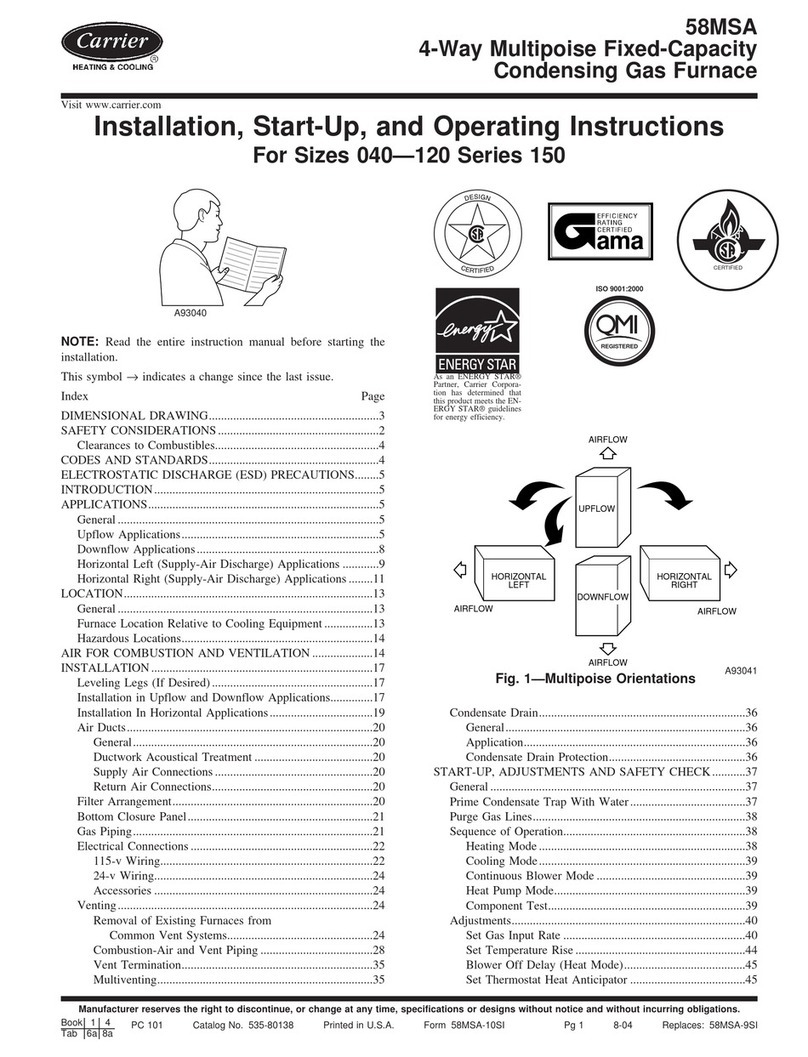
Carrier
Carrier 58MSA Series Installation, start-up, and operating instructions

Williamson-Thermoflo
Williamson-Thermoflo SCH High Boy Manual guide

Arcoaire
Arcoaire N9MP1 Installation instruction

Duo-Therm
Duo-Therm 66000 Series owner's manual
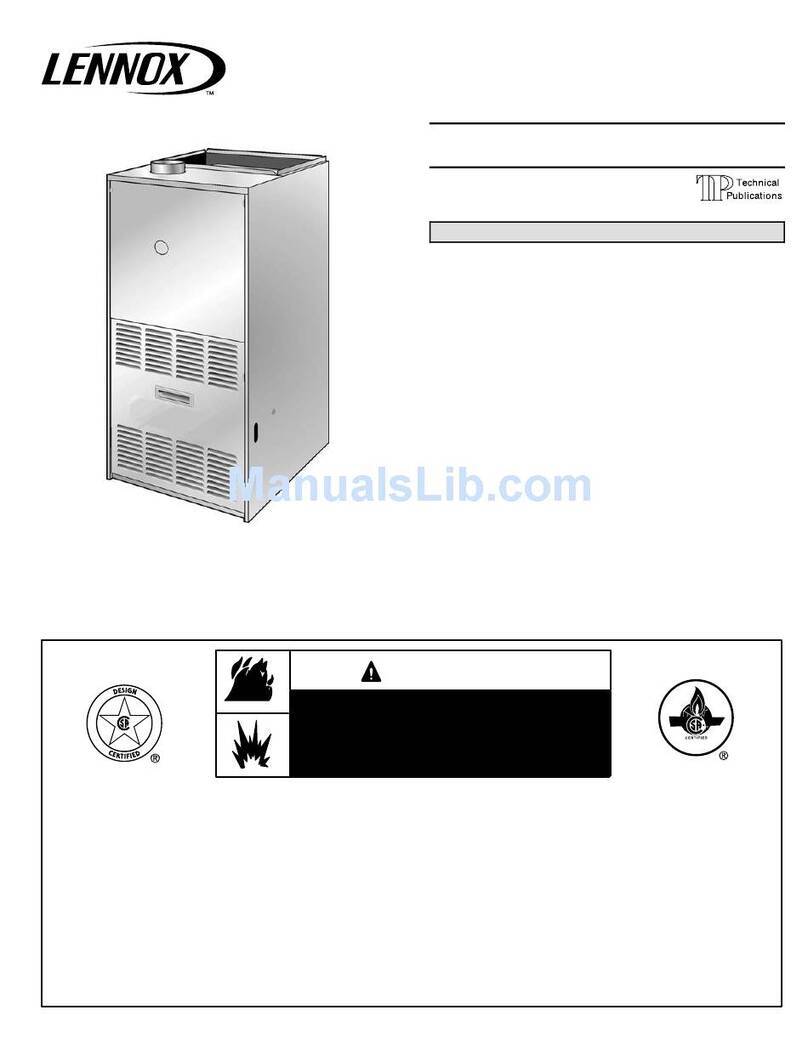
Lennox
Lennox G60DF(X) Series installation instructions
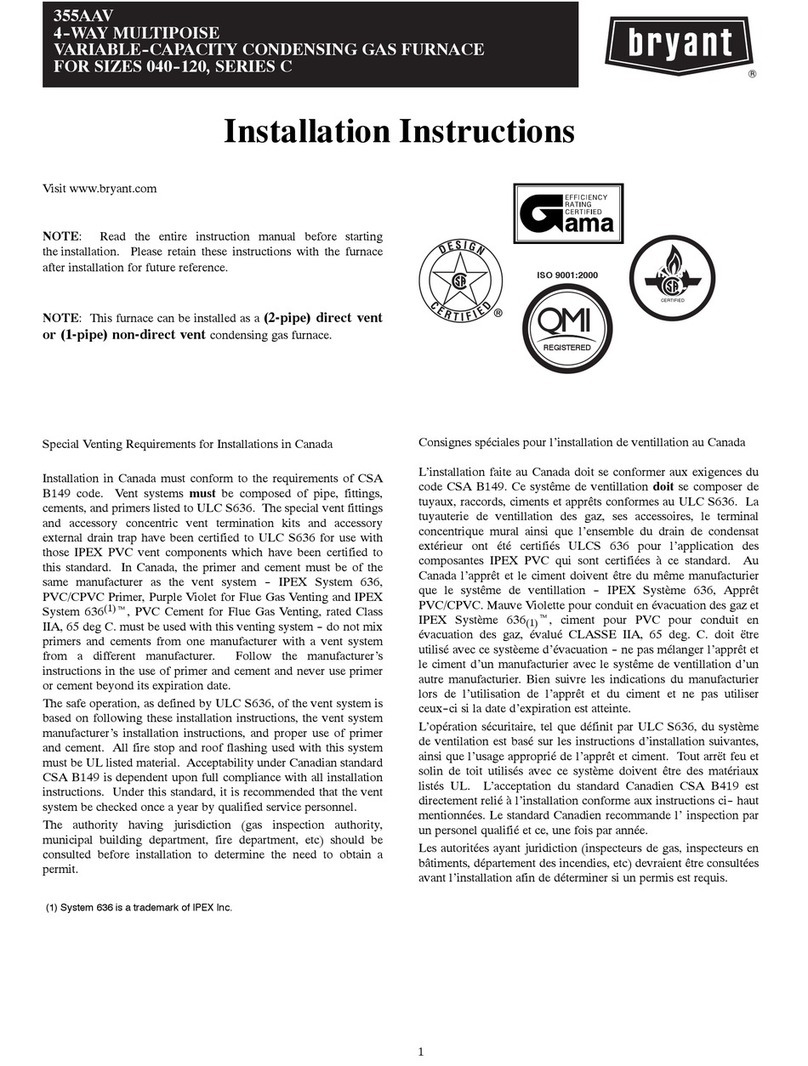
Bryant
Bryant 355AAV EVOLUTION installation instructions
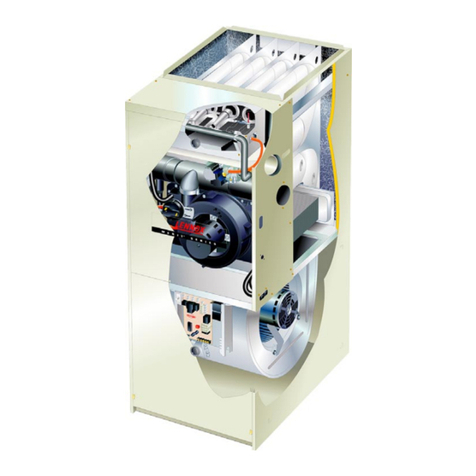
Lennox
Lennox G43UF SERIES Unit information

Amana
Amana M9S96 Series installation instructions

Carrier
Carrier Deluxe 58SXB installation instructions

Barnstead|Thermolyne
Barnstead|Thermolyne F62700 Operation manual
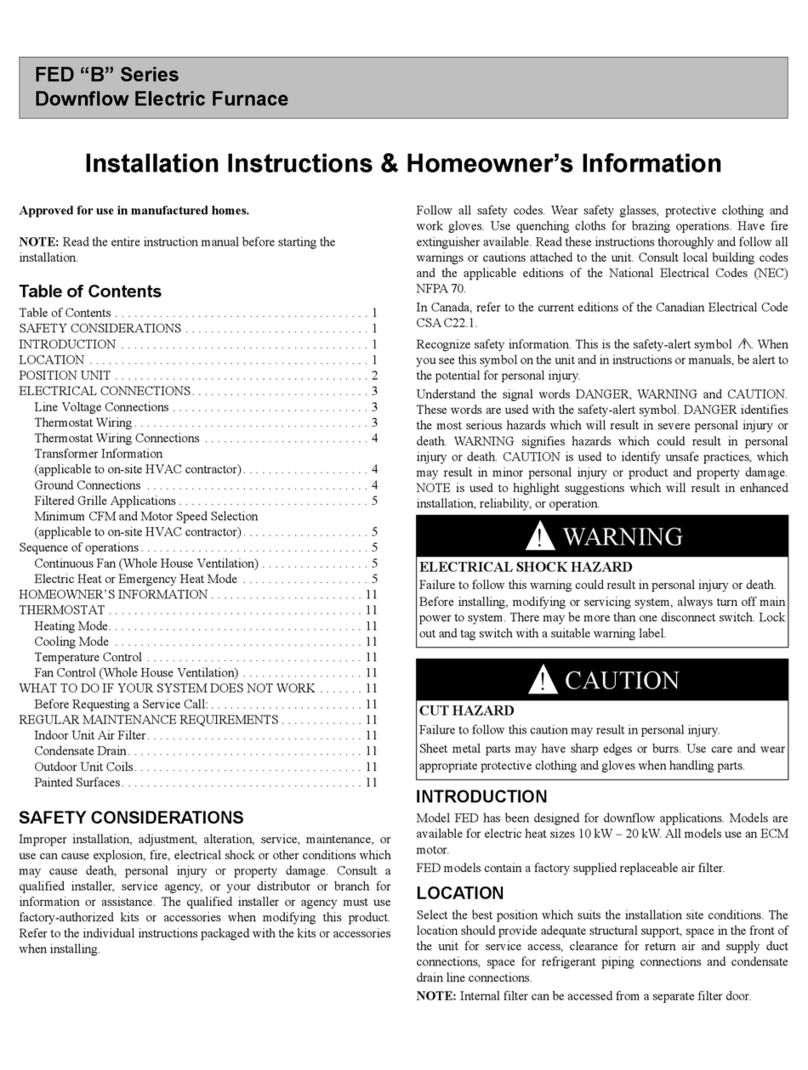
Carrier
Carrier FED B Series installation instructions
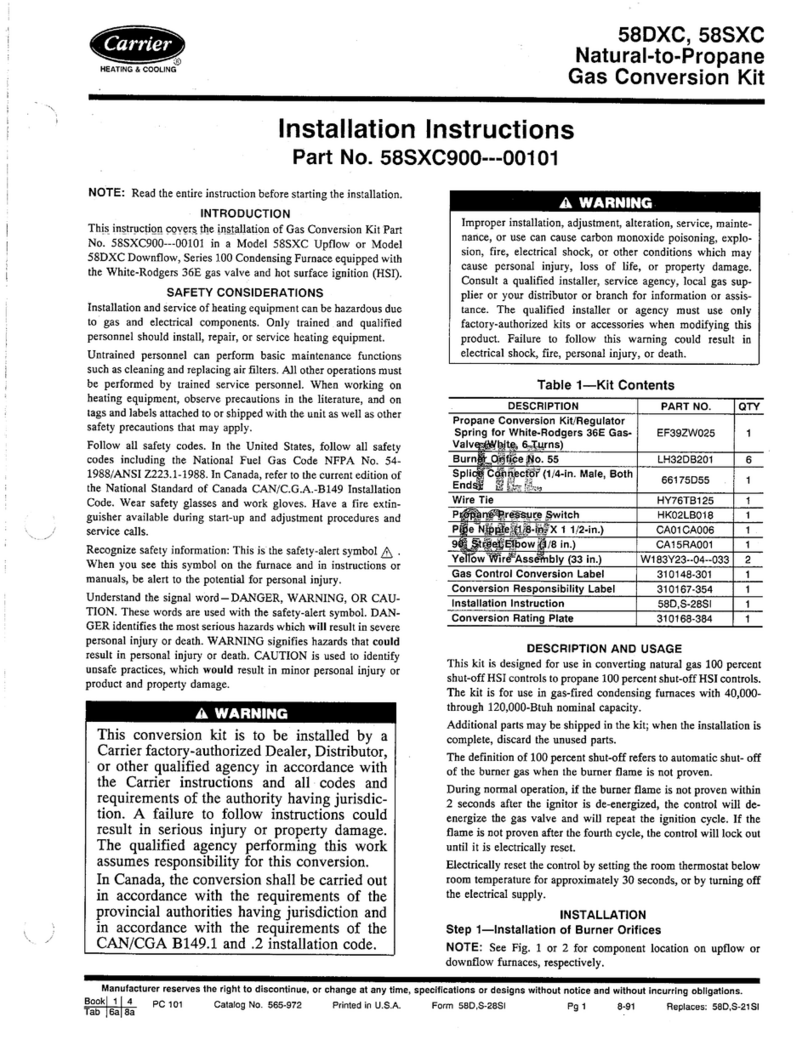
Carrier
Carrier DELUXE 58DXC installation instructions


